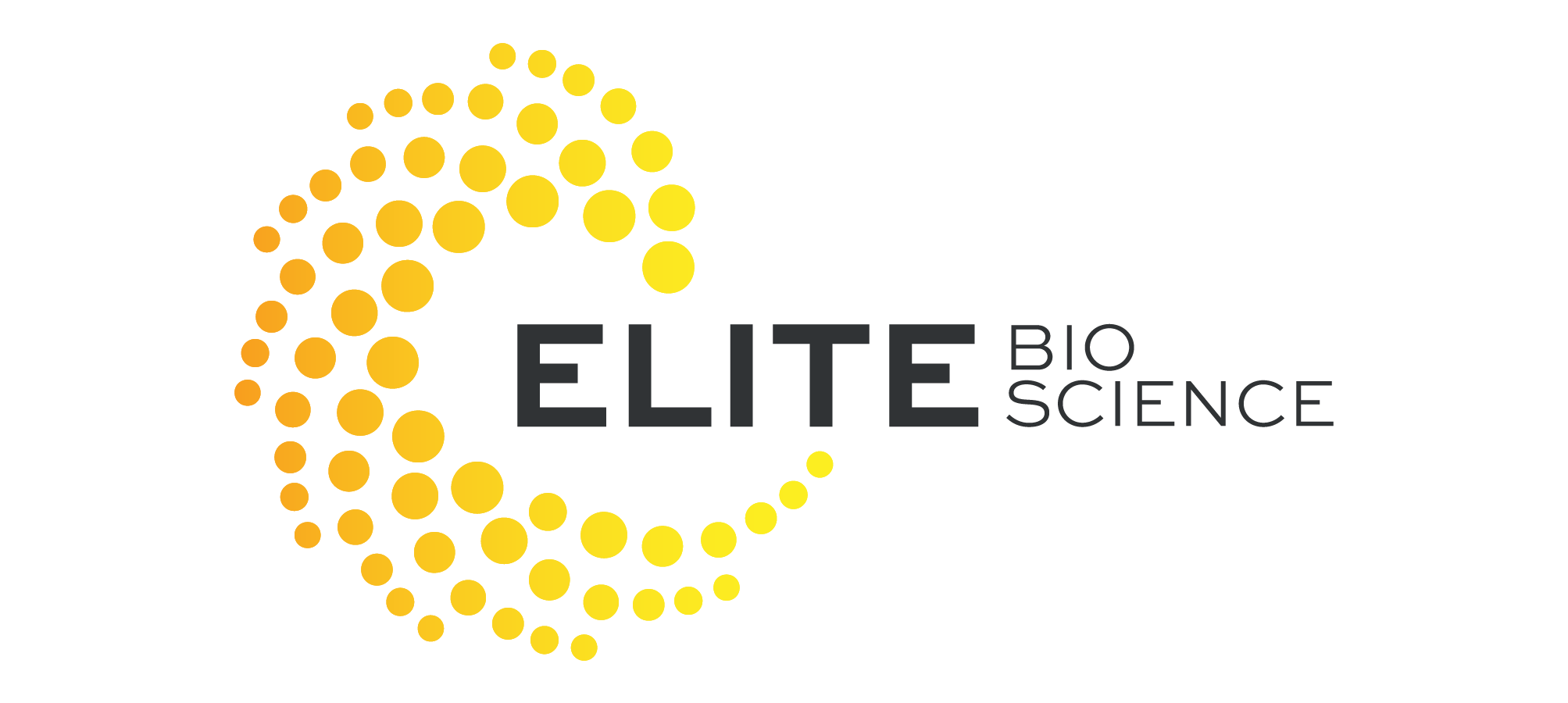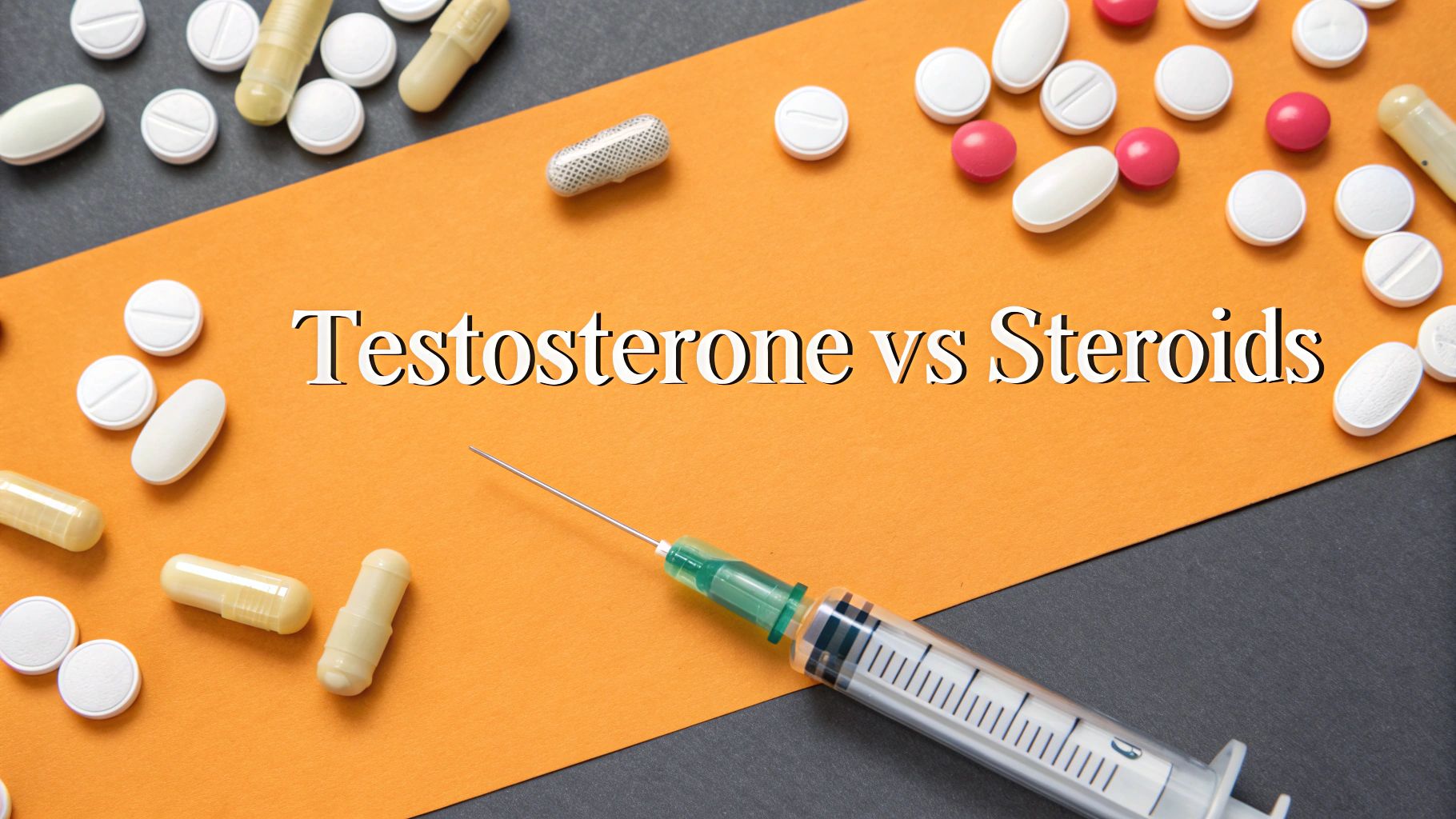What Are Peptides in Bodybuilding Explained

In bodybuilding, peptides are often misunderstood. They aren't another form of protein or a magic muscle-building material. Instead, think of them as highly specific messengers—short chains of amino acids that act as powerful signaling molecules.
Essentially, they give your body's cells direct instructions to accelerate muscle growth, speed up recovery, and enhance fat loss. They’re not the raw materials for the job, but rather the project managers telling your body how and when to build.
Decoding Peptides: A Simple Analogy
Let's cut through the complex science with a straightforward analogy. Imagine your muscles are part of a massive construction project. To build anything, you need two critical things: the raw materials and a clear set of instructions.
In your body, the raw materials are amino acids, which you get from the protein you eat. These are the bricks, steel, and concrete needed to construct dense muscle tissue. But a pile of materials doesn't just turn into a skyscraper on its own—it needs direction.
This is where peptides come in.
The Role of The Foreman
Peptides act like the project foremen on your muscle construction site. They are small, precise signaling molecules that carry specific blueprints and give direct orders to your cells (the construction crew). Instead of just dumping more bricks on the site, they deliver clear commands like:
- "Tell the pituitary gland to release more growth hormone now!"
- "Speed up the repair process on those damaged muscle fibers."
- "Start mobilizing stored body fat for energy."
By acting as messengers, peptides don't just add to the pile of resources; they optimize the entire construction process, making it faster and more efficient. This is the core reason they have become so significant in modern fitness and bodybuilding.
The global demand certainly reflects this. The market for muscular amino acids and peptides, valued at USD 5.2 billion in 2023, is expected to nearly double to USD 9.6 billion by 2033. This surge is largely driven by athletes seeking more efficient ways to repair and grow muscle. You can discover more insights on the growing peptide market on Dataintelo.
To really grasp their unique function, it helps to compare peptides directly with the protein supplements many of us already use.
Peptides vs Proteins Quick Comparison
The following table breaks down the key differences, showing why one is about raw materials and the other is about precise commands.
| Attribute | Peptides | Proteins (e.g., Whey) |
|---|---|---|
| Primary Role | Signaling molecules (Messengers) | Raw building blocks (Materials) |
| Size | Short chains of amino acids (2-50) | Long, complex chains of amino acids (50+) |
| Function | Give specific instructions to cells | Provide amino acids for tissue repair and synthesis |
| Analogy | The foreman with the blueprints | The bricks, steel, and concrete |
| Primary Goal | Optimize and direct bodily processes | Supply the raw fuel for growth |
This signaling function is what separates peptides from traditional supplements. While a protein shake delivers the raw materials for muscle repair, a peptide tells the body how to use those materials with incredible precision. This level of biological instruction is what makes understanding peptides so crucial for anyone looking to truly maximize their results. They offer a way to work with your body's systems, not just fuel them.
How Peptides Fuel Muscle Growth and Recovery

So we know peptides are the body's cellular messengers. But how do they actually deliver their instructions to build muscle? Their power is in their precision. Think of them like a specific key designed to fit a particular lock, allowing them to amplify the natural processes your body already uses for bodybuilding.
Peptides don’t build muscle tissue on their own. Instead, they act as powerful triggers, signaling your body to release its own anabolic hormones and creating the perfect internal environment for growth. They pull this off in two main ways: by cranking up growth hormone production and by putting recovery into overdrive.
Unlocking Growth Hormone Production
Certain peptides, known as secretagogues, are designed to send a direct message to your pituitary gland—the hormonal command center of your body. It’s like sending a high-priority text telling it to ramp up the manufacturing and release of Growth Hormone (GH).
This is a critical distinction. Instead of introducing a foreign hormone into your system, these peptides simply encourage your body to make more of its own. This natural spike in GH then sets off a cascade of benefits perfect for anyone serious about building muscle:
- Increased Protein Synthesis: Your body gets way more efficient at taking the amino acids from your food and using them to build new muscle.
- Enhanced Fat Metabolism: GH prompts your body to burn stored fat for energy, helping you stay lean while you pack on size.
- Boosted IGF-1 Levels: Growth hormone signals the liver to produce Insulin-Like Growth Factor 1 (IGF-1), another potent hormone that directly drives muscle cell growth and repair.
Peptides essentially act as a sophisticated volume knob for your body's natural growth machinery. They don’t rewrite the music; they just turn up the volume on the signals that lead to hypertrophy and improved body composition.
The Emergency Response Team for Recovery
Beyond just stimulating growth, another class of peptides works like a dedicated emergency response team for your muscles. After you crush a heavy workout, your muscle fibers are torn and inflamed. This is exactly where recovery peptides come in to manage the damage and rebuild everything stronger than before.
Picture your damaged muscles sending out a distress signal. Recovery peptides pick up that call and get straight to work, focusing on a few key actions:
- Reducing Inflammation: They help dial back the inflammatory response, which can cut down on debilitating soreness and get you back in the gym sooner.
- Improving Blood Flow: Many of these peptides promote angiogenesis, the creation of new blood vessels. This boosts the delivery of oxygen and nutrients to damaged tissue, supercharging the repair process.
- Accelerating Tissue Repair: By directly supporting the regeneration of muscle, tendon, and ligament tissues, they help you heal from the micro-trauma of training much more rapidly.
This supercharged recovery is an absolute game-changer. It means less downtime, a lower risk of overuse injuries, and the ability to handle greater training frequency and intensity. When you can recover faster, you can train harder and more often, leading to more consistent progress over time. For a deeper dive, you can explore more about how peptide therapy for muscle growth works to optimize these biological pathways.
Exploring Popular Bodybuilding Peptides
Not all peptides are created equal. Think of them as a team of highly specialized tools, where each one is engineered for a specific job. In the world of physique enhancement, this team has different departments: some are aggressive growth accelerators, others are meticulous recovery specialists, and a few are dedicated fat-loss agents.
Getting a handle on these categories is the first step to understanding how peptides are strategically used in bodybuilding. Let's break down the most common players you'll come across, grouping them by their primary mission.
Growth Hormone Accelerators
This group is easily the most famous in bodybuilding circles. Their main job is to send a signal to your pituitary gland, prompting it to release more of your body's own natural Growth Hormone (GH). It's a crucial distinction: these peptides don't introduce synthetic hormones; they simply ask your body to ramp up its own production.
- Ipamorelin: Often seen as one of the milder and more selective options, Ipamorelin triggers a clean pulse of GH without messing with other hormones like the stress hormone cortisol. This makes it a go-to choice for beginners or anyone looking for steady, quality gains with fewer potential side effects.
- CJC-1295: This peptide is a Growth Hormone-Releasing Hormone (GHRH) analog. It works hand-in-glove with peptides like Ipamorelin to create a much more powerful and sustained release of GH, making it a cornerstone in many muscle-building protocols.
- Sermorelin: Another GHRH analog, Sermorelin functions a lot like CJC-1295. By elevating natural GH levels, it helps promote lean muscle mass, reduce body fat, and significantly improve recovery times.
Recovery and Healing Specialists
Every hard training session creates micro-tears in your muscle and connective tissues. This is where recovery peptides truly shine, acting like an on-call repair crew to mend the damage, cool down inflammation, and get you back in the gym at full strength, faster.
- BPC-157: Short for Body Protection Compound, BPC-157 is legendary for its incredible healing properties. It accelerates the repair of muscles, tendons, ligaments, and even gut tissue, making it invaluable for dealing with those nagging injuries that just won't seem to go away.
- TB-500: Known for promoting cell migration and healing, this peptide is fantastic for improving flexibility, reducing joint inflammation, and speeding up recovery from acute injuries.
Many athletes find that BPC-157 and TB-500 work even better together, creating a powerful, synergistic healing effect. To learn more, check out our guide on the synergistic power of BPC-157 and TB-500.
The image below gives you a snapshot of key performance metrics—like absorption time and half-life—for some of these popular peptides.

This data really shows how different peptides have varied release patterns, which allows for protocols to be timed perfectly around workouts or sleep for maximum impact.
Fat Loss Agents
While most GH-releasing peptides also help with fat loss, some are specifically designed to target stubborn adipose tissue. These peptides work by helping your body mobilize stored fat so it can be burned for energy.
- AOD-9604: This one is a modified fragment of human growth hormone. It was specifically developed to keep the powerful fat-burning properties of GH without affecting muscle growth or blood sugar levels, making it a highly targeted tool for getting lean.
To give you a clearer picture, here's a quick-reference table outlining some of the most common peptides and what they're typically used for.
Popular Bodybuilding Peptides and Their Primary Functions
| Peptide Name | Primary Goal | Common Application |
|---|---|---|
| Ipamorelin | Muscle Growth | Stimulating a clean pulse of natural growth hormone. |
| CJC-1295 | Muscle Growth | Amplifying and sustaining growth hormone release. |
| BPC-157 | Recovery & Healing | Repairing muscle, tendon, and ligament injuries. |
| TB-500 | Recovery & Healing | Reducing inflammation and improving flexibility. |
| AOD-9604 | Fat Loss | Targeting and burning stored body fat. |
This table helps you quickly see how each peptide lines up with a specific fitness goal, from building mass to recovering from injury.
Understanding Peptide Cycles and Stacks

When it comes to using peptides, smart strategy beats sheer quantity every single time. Just taking a peptide day in and day out without a plan isn't the best way to get results. Instead, experienced users lean on two core principles to get the most out of their protocol while keeping safety in mind: cycling and stacking.
Getting the "why" behind these strategies is the key to designing a protocol that actually works. Cycling stops your body from tuning out the signals, while stacking creates a powerful synergy between different peptides to amplify their effects.
What Is Peptide Cycling?
Peptide cycling is simply the practice of using a peptide for a set period of time—what we call a "cycle"—and then following it with a planned break. This isn't just a random pause; it's a deliberate tactic to keep your body's receptors sensitive and ready to respond.
Think of it like your training program. You can't go to the gym and lift your absolute max every single day without a break, or you'll burn out and stop making progress. Peptides work in a similar way. If you constantly stimulate the same pathway, your body starts to downregulate its own natural processes, making the peptide less and less effective over time.
A typical cycle usually breaks down like this:
- On-Cycle: This is your period of consistent use, often lasting from 8 to 12 weeks, where you're working toward a specific goal like building muscle or repairing an injury.
- Off-Cycle: This is a break of at least 4 weeks. It gives your body a chance to reset its natural hormonal baselines and lets your receptors regain their full sensitivity.
This on-and-off approach ensures that every time you start a new cycle, your body responds with maximum efficiency. It's the best way to avoid diminishing returns and keep your protocol effective for the long haul.
The Power of Peptide Stacking
Stacking takes this strategic approach one step further. It involves combining two or more peptides that complement each other to create a synergistic effect. It’s like assembling a specialized team where each member makes the others better, producing a result that's far greater than what each could achieve alone.
A classic example in the world of bodybuilding is stacking a Growth Hormone-Releasing Hormone (GHRH) with a Growth Hormone-Releasing Peptide (GHRP).
- GHRH (like CJC-1295): This peptide acts as a signal telling your pituitary gland how much growth hormone it should release.
- GHRP (like Ipamorelin): This one tells the pituitary gland when it's time to release that growth hormone.
When you use them together, they create a much bigger and more sustained pulse of your own natural growth hormone than either one could ever trigger by itself. This synergy is the entire point of stacking—using different mechanisms of action to create a powerful, combined effect.
This same logic applies to stacking a recovery-focused peptide like BPC-157 with one geared toward muscle growth. One is busy healing your connective tissues while the other is focused on muscle hypertrophy. This allows you to train harder and bounce back faster at the same time. Intelligently designed stacks are the hallmark of any advanced and effective peptide protocol.
Navigating Peptide Safety and Legality
The power peptides offer for bodybuilding is undeniable, but that potential comes with a serious need for responsibility. Making smart decisions means looking beyond the benefits and getting a firm grasp on the safety and legal landscape surrounding them. This isn't a corner you can afford to cut; it’s the single most important part of the entire conversation.
Side effects are, of course, a major concern. The good news is they are often directly tied to the dose, the purity of the product, and your own body’s response. Some users might run into temporary issues like water retention, a tingling sensation in their hands or feet, or feeling more tired than usual. These are typically mild and tend to fade as the body gets used to the protocol or after a simple dose adjustment.
The Source Is Everything
When it comes to peptide safety, one factor stands above all others: the source. The market is, unfortunately, flooded with shady products sold as “research chemicals” by unregulated online vendors. Buying from these sources is a massive gamble.
- Purity Issues: You have no idea if what you’re getting contains contaminants, is underdosed, or even has the active peptide in it at all.
- Lack of Quality Control: There is zero oversight to ensure what's printed on the label actually matches what's inside the vial.
- Safety Risks: Using an impure or incorrectly dosed substance can trigger unpredictable and dangerous side effects.
The difference between a prescribed peptide from a licensed compounding pharmacy and a vial from an online "research chemical" site is night and day. One is a medically supervised tool; the other is a roll of the dice with your health. Exploring whether peptide therapy is safe begins with understanding this crucial distinction.
The Legal and Competitive Landscape
From a legal standpoint, peptides intended for human use are prescription drugs. This leads directly to their status in competitive sports, which is crystal clear. Organizations like the World Anti-Doping Agency (WADA) have an explicit ban on most performance-enhancing peptides. Any athlete who is subject to anti-doping rules must steer clear of these compounds completely to avoid disqualification.
The growing buzz around peptides is easy to see in the market trends. The global peptide supplements market, valued at around USD 4.1 billion in 2025, is expected to skyrocket to USD 11.2 billion by 2035. This boom shows just how much mainstream interest is growing, but it also shines a spotlight on the need for better education on how to access them safely and legally. Discover more insights about the peptide supplements market on Future Market Insights. At the end of the day, navigating this space safely means making medical guidance your top priority and completely rejecting the high-risk, unregulated market.
The Right Way to Access Peptide Therapy

Given the wild west nature of the unregulated market, knowing the legitimate pathway to peptide therapy is absolutely critical for your safety and results. The right approach treats peptides not as mysterious online chemicals but as a supervised medical tool for optimizing your health. This modern process ensures everything is tailored specifically to your unique biology.
The entire journey is guided by licensed medical professionals, usually through telehealth platforms or specialized clinics that put patient care above everything else. This is a world away from the guesswork and genuine danger of buying from anonymous websites.
The Medically Supervised Process
The legitimate pathway is a structured, multi-step process designed to put your health first. It's nothing like the "click-to-buy" model you see on the gray market, and it guarantees you receive a protocol built for your body and your goals.
This professional model treats peptide therapy with the seriousness it deserves, focusing on building a safe and effective plan. Here’s a step-by-step look at how it works:
- Initial Doctor Consultation: The process always kicks off with a detailed consultation with a licensed doctor. This is where you’ll dive into your health history, current fitness level, and specific goals—whether that’s packing on muscle, speeding up recovery, or shedding body fat.
- Comprehensive Blood Work: Before any prescription is even considered, you'll undergo comprehensive blood tests. This diagnostic step is crucial. It gives your doctor a crystal-clear picture of your hormonal baseline and overall health, letting them spot any underlying issues and design a protocol that's actually safe for you.
- Personalized Protocol Design: Armed with your consultation notes and lab results, the doctor designs your personalized peptide protocol. This includes the specific peptides, exact dosages, and the cycle length best suited to help you crush your objectives without taking on unnecessary risks.
- Prescription from a Compounding Pharmacy: If a prescription is right for you, your peptides are sourced directly from a licensed and regulated compounding pharmacy in your country. This guarantees the purity, potency, and sterility of what you receive, completely wiping out the dangers linked to unregulated online sellers. This final step ensures you get a legitimate, medical-grade product for your therapy.
Answering Common Questions About Peptides
As you dive into the world of peptides, a few key questions almost always come up. Getting clear, straightforward answers is crucial for building confidence and understanding exactly what peptides in bodybuilding are—and what they are not. Let's tackle some of the most frequent inquiries.
Are Peptides A Type Of Steroid?
Not at all. This is one of the biggest misconceptions out there. Peptides and anabolic steroids are entirely different compounds that work in completely separate ways.
Think of peptides as your body’s natural text messaging system. They are short chains of amino acids that send specific signals, like telling your pituitary gland to release its own growth hormone. Steroids, on the other hand, are synthetic versions of hormones like testosterone that directly force muscle growth by binding to androgen receptors. Their chemical structures, functions, and side effect profiles are worlds apart.
How Long Does It Take To See Results?
Patience is the name of the game here. Results can vary widely depending on the specific peptide you're using, your dosage, diet, and how hard you're training.
You won't see changes overnight. Peptides work by optimizing your body's natural systems, a process that requires consistency over time to yield noticeable improvements in muscle growth or fat loss.
For example, a recovery-focused peptide like BPC-157 might offer relief from joint discomfort within just a few weeks. But for visible changes in muscle mass or body composition, most people report seeing initial results after 4-6 weeks, with more significant progress becoming apparent over a full 12-week cycle.
Can You Buy Peptides Over The Counter?
No, and this is a critical point for your safety. Legitimate peptides intended for human use are prescription-only medications. The products you might find sold online as "research chemicals" exist in a dangerous, unregulated gray market.
When you buy from these sources, there is absolutely no guarantee of purity, dosage, or safety. The only safe and legal way to access peptide therapy is through a prescription from a qualified medical professional. This ensures the product is sourced from a licensed compounding pharmacy, giving you a pure and accurately dosed medication.
At Elite Bioscience, we connect you with licensed doctors who design personalized therapy plans based on your unique health data. Start your confidential health assessment today to access safe, effective, and medically supervised peptide treatments delivered right to your door.
QUICK SEARCH
Make an account today to start your journey towards a better and healthier lifestyle.






